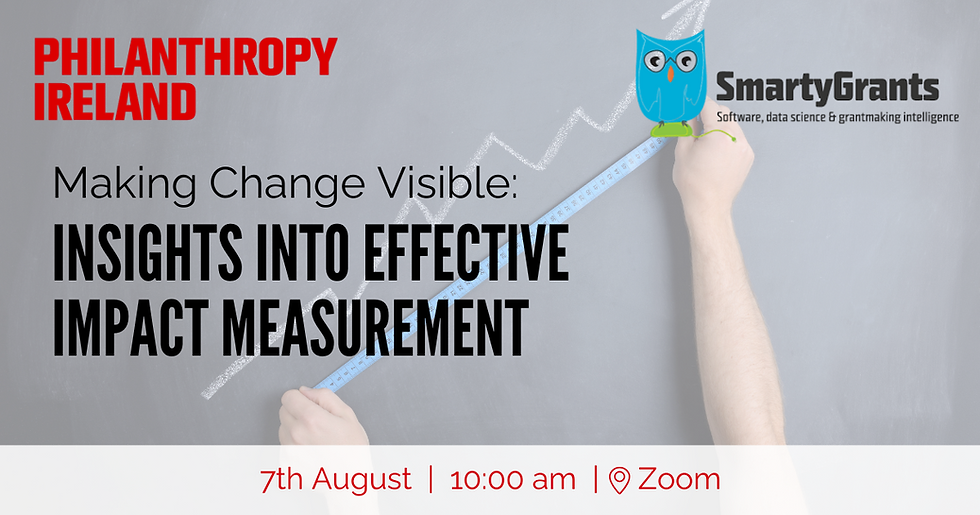Harnessing the Power of AI for Philanthropy: Navigating Potential and Risks in Grant Making
- Mar 20, 2024
- 3 min read
Updated: Jul 14
By: Hazel Hennessy, Philanthropy Ireland

Harnessing the Power of AI for Philanthropy: Navigating Potential and Risks in Grant Making
In the realm of philanthropy, the integration of artificial intelligence (AI) is opening up new possibilities and challenges for grant makers. As AI continues to evolve and shape our technological landscape, it is crucial for trustees and leaders in the philanthropy sector to grasp the potential of this technology in driving positive impact aligned with their charitable mission and values. Understanding how to leverage AI effectively while also being mindful of the associated risks is key to maximizing the benefits of AI in grant making.
Why is AI important for grant makers?
Grant makers play a pivotal role in allocating resources to support initiatives and projects that address societal challenges. With the transformative potential of AI to revolutionise industries, enhance efficiency, and foster innovation, grant makers have the opportunity to invest in projects that harness AI to drive positive change. By embracing AI, grant makers can empower marginalised groups, enhance operational efficiency, and support key social issues in communities.
However, alongside the promise of AI lies a set of risks that must be carefully managed. Grant makers must navigate the evolving AI landscape with caution, considering potential biases in algorithms, privacy concerns, and misinformation. It is essential for grant makers to make informed decisions, develop internal frameworks for AI usage, and ensure ethical and equitable implementation of AI in their philanthropic endeavours.
Potential benefits of AI in philanthropy:
Levelling the playing field for marginalized groups: AI can help overcome barriers such as language and education limitations in grant applications, enabling a more inclusive and diverse pool of beneficiaries.
Game-changing technology for social issues: AI has the potential to address key societal challenges and drive innovation in philanthropic initiatives.
Augmenting capabilities and freeing up time: AI can enhance organisational efficiency, allowing staff to focus on mission-oriented tasks such as networking, donor care, and fundraising.
Supporting operational work and mission alignment: AI can serve as a valuable tool for philanthropic organisations, aligning their operations with government policies and ensuring mission alignment with philanthropic goals.
Identifying and managing risks:
Grant makers need to ask critical questions about the use of AI in funded projects, ensuring that partners have considered ways AI can enhance project capacity rather than rendering certain activities obsolete. Ethical data training is crucial to prevent biases in AI-generated information. Grant makers must also be vigilant about harmful information dissemination, perpetuation of stereotypes, and environmental impacts of AI technology.
Supporting nonprofits in advancing AI usage:
The philanthropy community in Ireland can play a pivotal role in encouraging beneficiaries to explore the potential of AI for furthering their charitable missions. Initiatives such as Microsoft’s investment in workforce development, the Gates Foundation’s grant challenge for equitable AI, and Omidyar’s fund emphasizing responsible AI implementation showcase the potential of AI in philanthropy. Philanthropy can lead the way in promoting ethical AI use, capacity building, and sector-wide frameworks for AI adoption.
Implementing AI for organisational advancement:
AI should complement human workers, not replace them, by augmenting tasks and enhancing productivity. The redefinition of productivity to encompass mission-critical tasks can help organisations leverage AI effectively. A roadmap for responsible AI use, encompassing individual experimentation, organisational adoption, training, and policy development, can guide nonprofits towards ethical and effective AI implementation.
In conclusion, AI presents both opportunities and challenges for grant makers in the philanthropy sector. By embracing the potential of AI while addressing associated risks, grant makers can drive positive impact, foster innovation, and ensure ethical and equitable use of AI in their philanthropic endeavours. Navigating the complexities of AI in grant making requires a thoughtful approach that balances innovation with ethical considerations, paving the way for a more impactful and sustainable philanthropic landscape in Ireland.





Comments